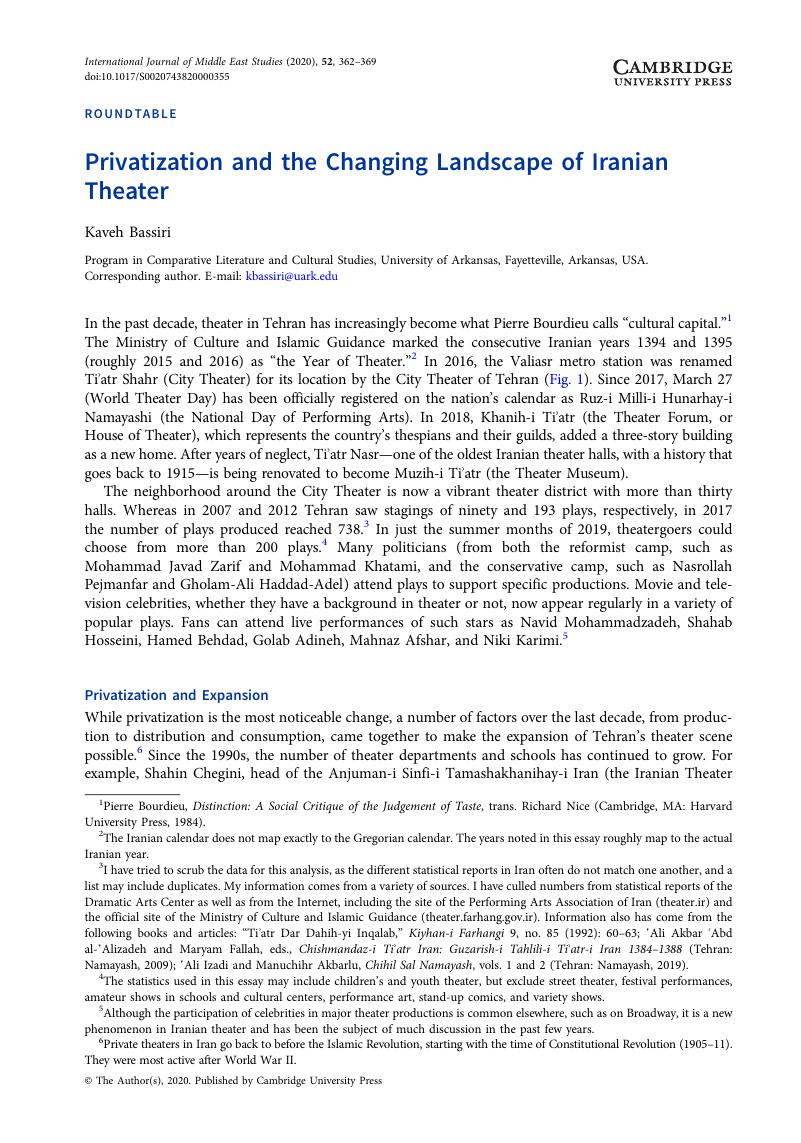Published online by Cambridge University Press: 28 May 2020

1 Bourdieu, Pierre, Distinction: A Social Critique of the Judgement of Taste, trans. Nice, Richard (Cambridge, MA: Harvard University Press, 1984)Google Scholar.
2 The Iranian calendar does not map exactly to the Gregorian calendar. The years noted in this essay roughly map to the actual Iranian year.
3 I have tried to scrub the data for this analysis, as the different statistical reports in Iran often do not match one another, and a list may include duplicates. My information comes from a variety of sources. I have culled numbers from statistical reports of the Dramatic Arts Center as well as from the Internet, including the site of the Performing Arts Association of Iran (theater.ir) and the official site of the Ministry of Culture and Islamic Guidance (theater.farhang.gov.ir). Information also has come from the following books and articles: “Tiʾatr Dar Dahih-yi Inqalab,” Kiyhan-i Farhangi 9, no. 85 (1992): 60–63; ʿAbd al-‛Alizadeh, ‛Ali Akbar and Fallah, Maryam, eds., Chishmandaz-i Tiʾatr Iran: Guzarish-i Tahlili-i Tiʾatr-i Iran 1384–1388 (Tehran: Namayash, 2009)Google Scholar; Izadi, ‛Ali and Akbarlu, Manuchihr, Chihil Sal Namayash, vols. 1 and 2 (Tehran: Namayash, 2019)Google Scholar.
4 The statistics used in this essay may include children's and youth theater, but exclude street theater, festival performances, amateur shows in schools and cultural centers, performance art, stand-up comics, and variety shows.
5 Although the participation of celebrities in major theater productions is common elsewhere, such as on Broadway, it is a new phenomenon in Iranian theater and has been the subject of much discussion in the past few years.
6 Private theaters in Iran go back to before the Islamic Revolution, starting with the time of Constitutional Revolution (1905–11). They were most active after World War II.
7 “Khususi Saz-yi Ti'atr Niyazmand Harasat Ast,” Islamic Republic News Agency, 19 May 2019, www.irna.ir/news/83319600.
8 Farah Yeganeh, “Iranian Theatre Festivalised,” in Festivalising!: Theatrical Events, Politics and Culture, ed. Temple Hauptfleisch et al. (Amsterdam: Rodopi, 2007), 172.
9 “Ba Tiwall Ashna Shavid,” Islamic Republic News Agency, 21 September 2013, www.isna.ir/news/92063019217. Tiwall is not a completely open platform. For example, comments may be deleted if the site or the producers deem them inappropriate.
10 There was an established model that allowed thespians to be paid based on lifetime experiences and records.
11 Articles from this proceeding were later published: Mehrdad Rayani Makhsous (ed.), Ti'atr-i Khususi Dar Iran, 19–21 January 2009 (Tehran: Namayash, 2009).
12 Although all productions are ultimately under the authority and supervision of the Ministry of Culture and Islamic Guidance, the city and the state may support and manage the arts in different ways. By focusing on attracting audiences and revenue, the city-owned Iranshahr Theater presented a different model than the state-owned City Theater.
13 “Hisrathay-i Bih Dil Mandih,” Islamic Republic News Agency, 16 June 2019, www.isna.ir/news/98032611913.
14 See the AV Theater Group website, www.avtheatre.ir/AboutEn.aspx, accessed 1 October 2019.
15 Ashofteh, Reza. “‘Binavayan’ Husiyn Parsayi, Rukudzani [sic] Ya Ghabta-ha Va Hisadat-ha,” Honaronline, 21, April 2019, www.honaronline.ir/fa/tiny/news-133462. (There is a typo in the actual title of this article.)
16 “Taqriban Az Har Dah Irani Yek Nafar Bih Ti'atr Miravad,” Iranian Students Polling Agency (ISPA), 12 May 2019, ispa.ir/Default/Details/fa/2046/تقریبا - از - هر - ده - ایرانی - یک - نفر-به - تئاتر-می -رود. In contrast, only 30 percent have never gone to movies. See ISPA report from the same day, ispa.ir/Default/Details/fa/2048/سینمای - ایران - به - روایت - نتایج - نظرسنجی - ایسپا.
17 The minimum base salary for an employee is currently 18 million rials in a month.
18 These data are from recent statistical reports found for each season on the Iranian theater website, accessed 1 November 2019, theater.ir. For example, for summer 1998 see theater.ir/fa/125689.
19 Rob Weinert-Kendt, “The Gender and Period Count: The More Things Change . . .,” American Theater, 26 September 2017, www.americantheatre.org/2017/09/26/the-gender-period-count-the-more-things-change.
20 The dates are based on the last year and latest production. I have focused on the most recent performances.
21 For example, in 2018 the 16th International Resistance Theater Festival in Tehran hosted twenty-seven productions, including thirteen street plays.
22 Moosavi, Marjan, “Desacralizing Whispers: Counter-Conduct in the Iranian War Theatre,” New Theatre Quarterly 34, no. 3 (2018): 239CrossRefGoogle Scholar.
23 These data are from recent statistical reports that also can be found on the Iranian theater website, theater.ir.
24 This situation also is true in plays about the display of violence discussed earlier.
25 Talajooy, Saeed, “Indigenous Performing Traditions in Post-Revolutionary Iranian Theatre,” Iranian Studies 44, no. 4 (2011): 501CrossRefGoogle Scholar.
26 The Fadjr festivals coincide with the annual celebration of the Islamic Revolution and the return of Ayatollah Khomeini in 1979.